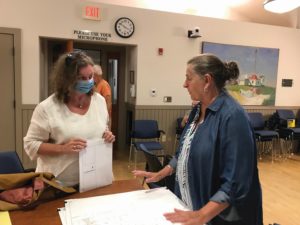TRURO — Habitat for Humanity of Cape Cod found itself embroiled in a superior court battle the last time it proposed a plan to build three affordable homes on a narrow strip of land at 181 Route 6 — a battle it ultimately lost.

Now Habitat is facing a new struggle over the same controversial site on the east side of the highway between the Pamet roads and Union Field Road.
The nonprofit organization has returned with a revised plan for the 1.78-acre property and hopes to avoid another trip to court by holding citizen forums and addressing public concerns before finalizing its proposal. Habitat will then go before the zoning board of appeals seeking a comprehensive permit under the state’s Chapter 40B affordable housing law.
Questions About the Grade
The first public forum was held on July 28 and drew about 25 residents with questions about noise, lighting, potential runoff and erosion on the steep site, and possible contamination of their wells from septic systems.
The biggest challenge is the steep grade of the property, which was a factor in the superior court’s decisions overturning a previous 40B comprehensive permit secured by Habitat. Those at the forum expressed the opinion that the challenge might just be too much to overcome.
“You’re building on the side of a sandy hill,” said Warren Green, who lives just north of the Habitat site on Avery Hill Way. “I know exactly what’s there — I live on it,” said Green. He called the area “a sandpit.” Septic systems would present a huge concern, he said, because of the proximity of neighbors’ wells.
“These wells are all going to be contaminated,” he said.
Voters at the annual town meeting in April 2013 approved the purchase of the land for affordable housing. The Truro Housing Authority donated it to Habitat for Humanity with a performance clause specifying that the land would be returned to the town if Habitat homes were not built.
The site isn’t ideal because it’s on a steep slope. As Habitat of Cape Cod CEO Wendy Cullinan pointed out at the forum, her organization would love to have a level lot to work with — but those aren’t the ones that are donated.
Habitat has changed some of the features of its earlier proposal. The home sites have been shifted to the north side of the lot to protect some abutting properties. Instead of bringing in fill to level the steep grade on the site, Habitat’s engineer John O’Reilly said the latest plan calls for cutting into the slope, installing a six-foot retaining wall, and leveling the area where the houses would be built.
And instead of three three-bedroom houses, the new plan calls for two three-bedroom houses and one house with a single bedroom.
The sole access to the three houses would be a paved driveway from Route 6, which would change to gravel in front of the houses, O’Reilly said. There would also be a comprehensive stormwater management plan, he said, but it has not yet been developed. Slopes would be planted to prevent erosion, and a temporary irrigation system would be installed until the vegetation was well established, O’Reilly said.
Brenda Connors, who lives downhill from the site at 4 Avery Way, filed suit in superior court to overturn the permit for the original plan seven years ago and won. The town appealed that decision but lost.
Connors came to the July 28 forum to hear details of the new plan. She was not persuaded.
“I’m at the very bottom of a precipitous slope,” said Connors, describing the hill as “like a triple black diamond” ski run. “The slope is that steep, and I’m concerned about gravity.”
John Dorfman doesn’t live near the site, but he attended the forum to listen to Habitat’s proposal. Dorfman wondered who would be responsible for maintaining the erosion measures, such as the retaining walls, when Habitat wasn’t there.
“If, 10 years from now, the vegetation dies, then what happens?” Dorfman asked.
Beth Wade, Habitat’s director of land acquisition and project development, said a home owners’ association would be established to share future maintenance costs.
Her organization also stays involved with the owners of houses it builds, she said, by attending the annual meetings of home owners’ associations.
People or Topography?
Cullinan, the Habitat CEO, commented that she was getting the sense that those at the forum “were afraid of those people” who would be living in the houses to be built. Habitat home owners won’t be hanging out on their decks and making noise, she said.
“These people will be going to work,” Cullinan said.
Some forum attendees took issue with Cullinan’s comment, arguing that the area’s topography makes the property unsuitable for building.
“It has nothing to do with the people that are going to live there,” said resident George Driscoll. “It has to do with anybody living there. It seems that this is a lot that could very well be an unbuildable lot. The damage could be catastrophic to people downhill.”
Another Habitat project planned for Wellfleet, four single-family houses on Old King’s Highway, remains under appeal in Barnstable Superior Court. The appellants sued Habitat and the Wellfleet Zoning Board of Appeals, which issued the requested 40B comprehensive permit for the project.
A trial before a judge in that case was held in April, and both sides have submitted final statements.
Of the nine abutters who originally appealed the comprehensive permit, four remain: Martin and Felicia Magida, Jean Rubinstein, and Charles Merzbacher. All own property within 300 feet of the target site.
Attorney John McCormick, representing the abutters, cited concerns about the overdevelopment of Old King’s Highway, a narrow unpaved road, the effects on the neighborhood’s character, and inadequate drainage mitigation and stormwater management resulting from the lot’s slope.



